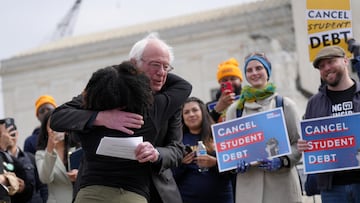Why can the Supreme Court reject more than 26 million student loan forgiveness applications?
The US Supreme Court will decide the fate of President Biden’s student debt relief program. Could it be overturned for the more than 26 million who applied?

All eyes are on the US Supreme Court as the justices begin to hear oral arguments regarding the constitutionality of President Biden’s student debt relief program. The question in the case examines the authority of the Department of Education to forgive student debt for loans that were issued by the federal government.
The court’s opinion, while the final word on the president’s executive order issued last summer, is not the deciding factor in the legality of future laws or proposals to assist borrowers and address the student debt crisis.
During the first three-hour session, where oral arguments were heard, Chief Justice John Roberts presented himself as one of the most skeptical justices regarding the legality of the White House’s program. The chief justice’s primary concerns focused on fairness and the financial loss the government would see if the debt was forgiven. On the latter topic, Justices Sotomayor and Kegan stated that the program’s price tag was not relevant to the legal question of the president’s authority.
Issues related to equity and justice were also echoed by Justice Samuel Alito, who repeatedly asked Solicitor General Elizabeth Prelogar to justify the fairness of the program rather than probing into the legal arguments made by each side.
Under a different line of questioning, Justice Brett Kavanaugh spent his time examining the value of expanding executive power during national emergencies. “Some of the biggest mistakes in the court’s history were deferring to assertions of executive or emergency power. Some of the finest moments in the court’s history were pushing back against presidential assertions of emergency power,” said Kavanaugh when describing his reservation about the government’s case.
Based on the response from the conservative wing of the country’s highest court, Presidnet Biden aired doubts earlier this week that his plan will be upheld by the court.
On the Question of Fairness
The chief justice asked why taxpayers who did not attend college and may have a lower annual income than many college graduates should have to foot the bill. Specifically, Justice Roberts asked why forty-three million people should have all or part of their student debt forgiven when others who have not attended college and may have an annual income lower than the average college graduate are forced to foot the bill. These comments echo those made by Republican lawmakers who have tried to argue that the measure is unpopular.
Polls conducted by YouGov/The Economist and Quinnipiac University have tracked that a majority of registered voters approve of the president’s plan that provided:
- Up to $20,000 in relief to those who make under $125,000 a year AND received a Pell Grant
- Up to $10,000 in relief for those that make under $125,000 a year.
The polling showed that support for student debt relief reaches beyond those that would benefit directly.
Families and borrowers are not viewed as the main culprits of the student debt crisis
Support for the program demonstrates a piece of the voting population whose politics is based on more than self-interest. Sixty percent of voters also supported the claim that student debt relief could help families buy a home or start a family, particularly lower-income borrowers who see will see a major chunk of their budget go to debt payments once the moratorium ends.
YouGov’s poll also showed that student loan borrowers are the group viewed as least responsible for the current crisis, with only around forty-nine percent of respondents saying that they are “a lot” or “a little” to blame. Only forty-six percent of those questioned said that the blame lies with parents and families of borrowers who may have encouraged the student to take out loans to fund their education.
Institutions seen as most responsible for the student loan crisis included the banks and financial institutions (76 percent), the federal government (66 percent), and state governments (61 percent). Additionally, around fifty-six percent of respondents believe that inflation would either decrease or stay the same if the program was enacted. Massachusetts Senator Elizabeth Warren responded to news from the Supreme Court by highlighting how the crisis has student debt crisis has escalated since she attended university.
Not only are so many borrowers underwater on their loans, with some paying so much in interest that they cannot make a dent in their principal balance, but access to a bachelor’s degree is becoming lower and lower as prices rise rapidly.






